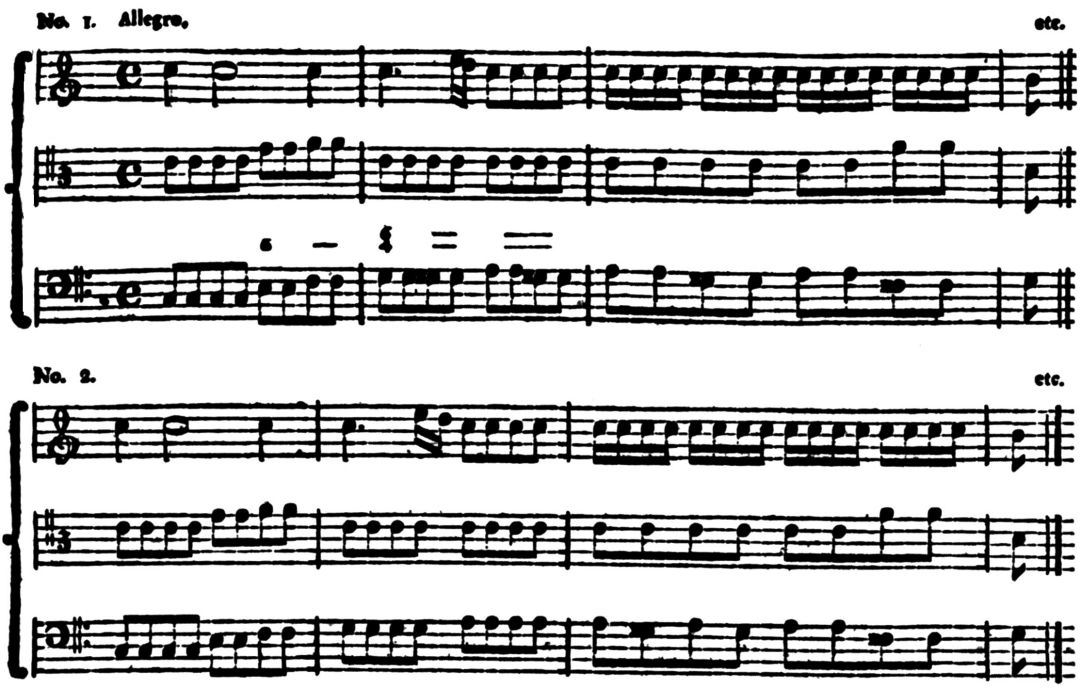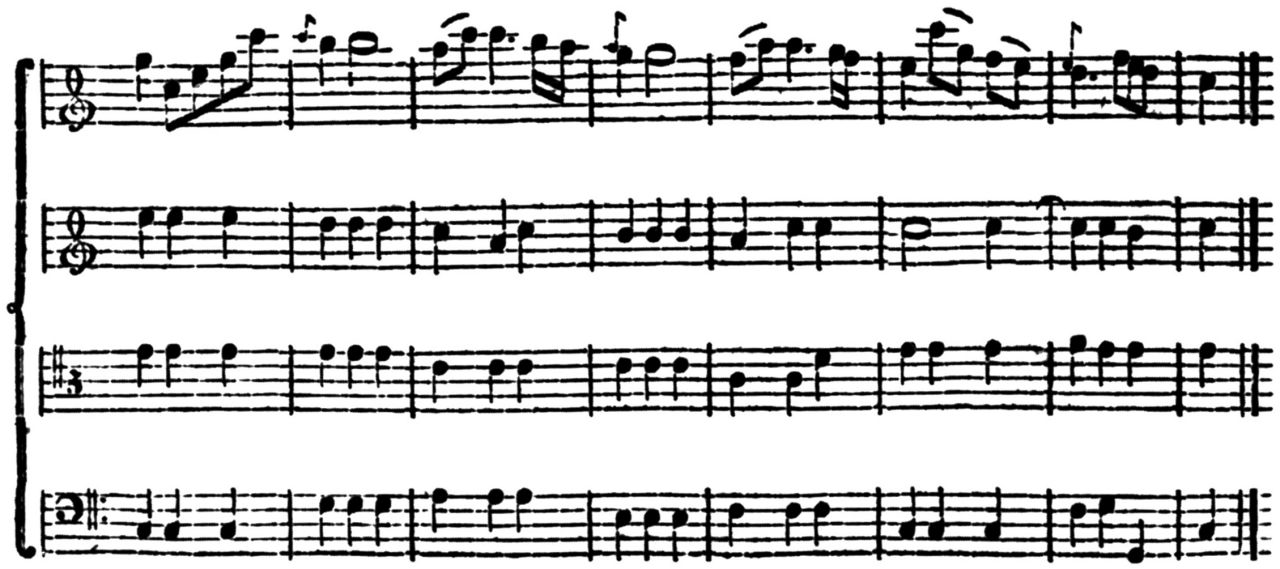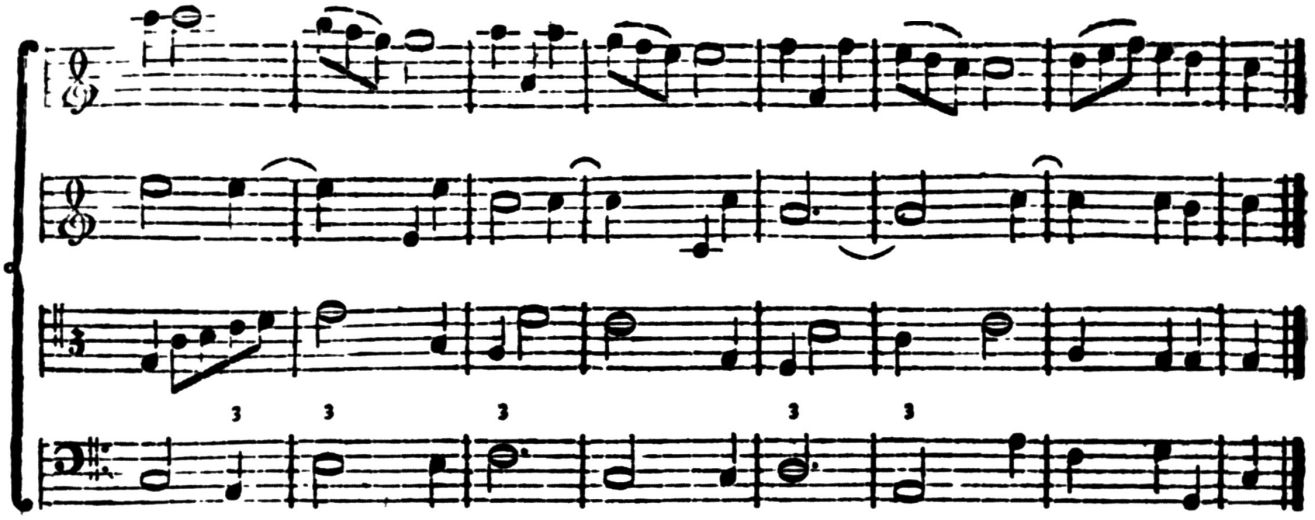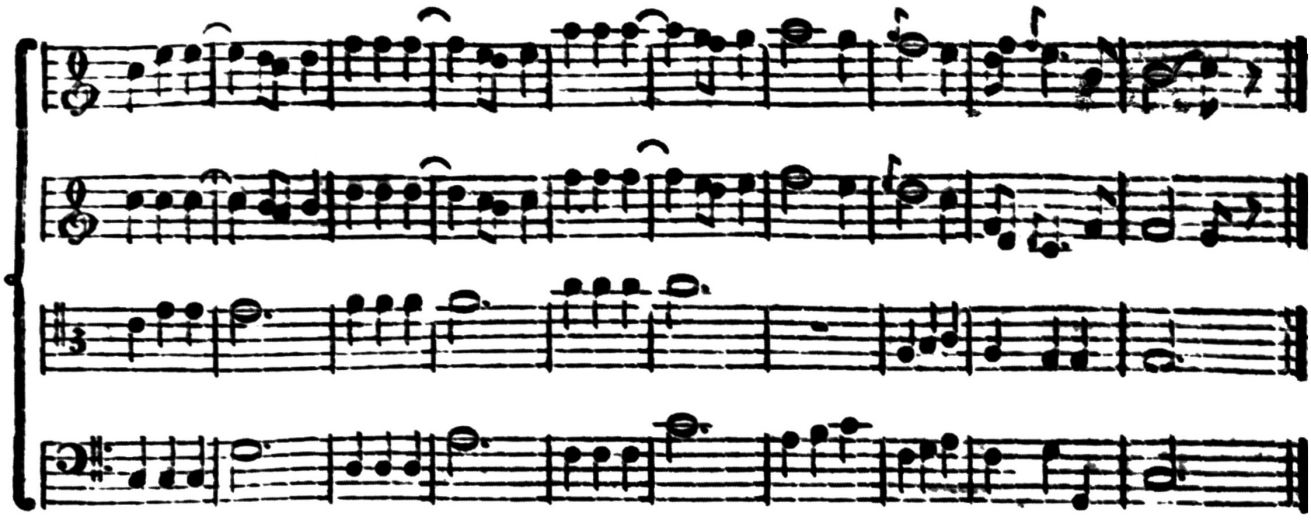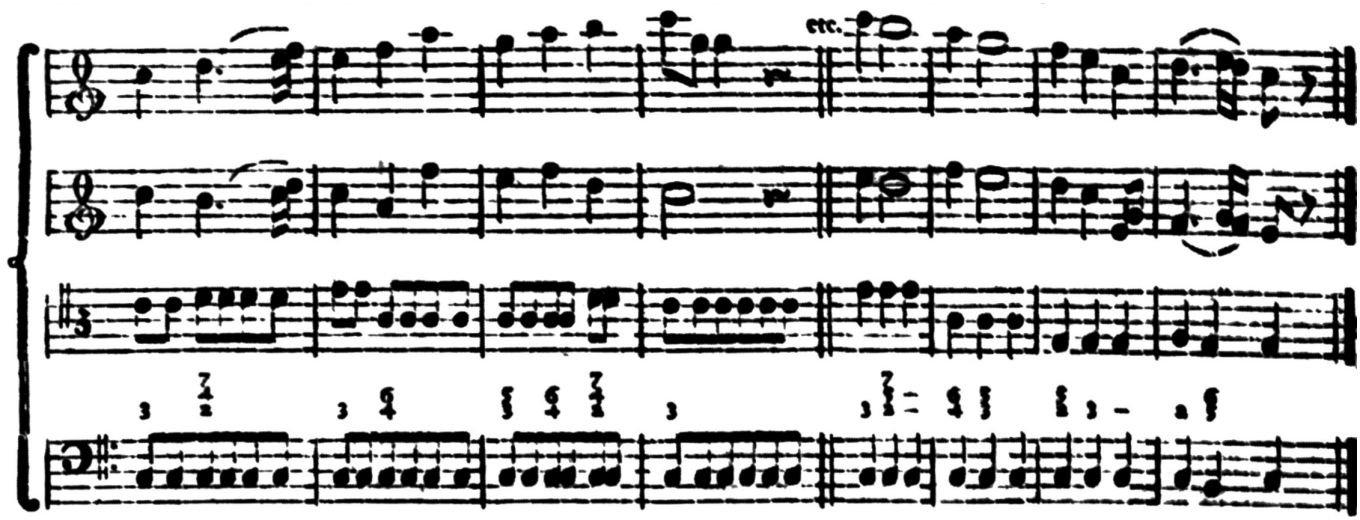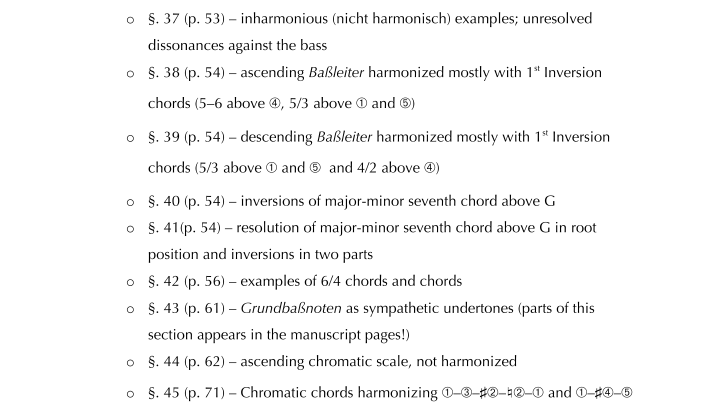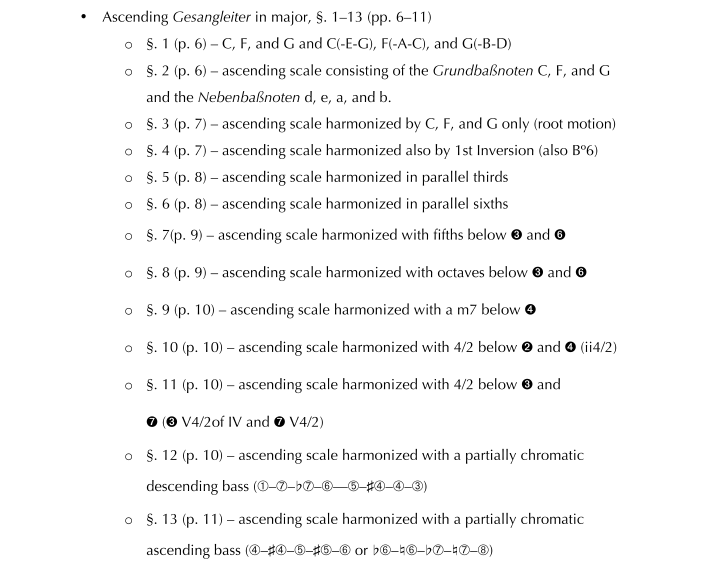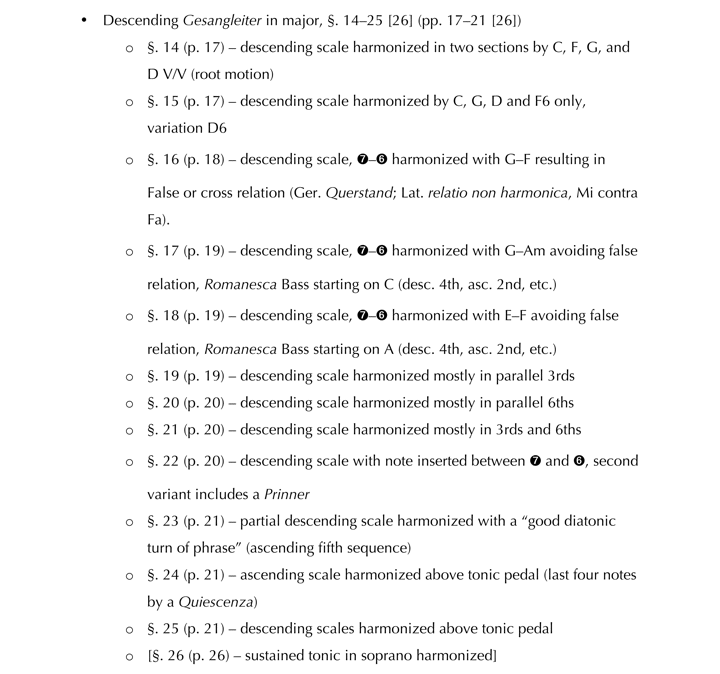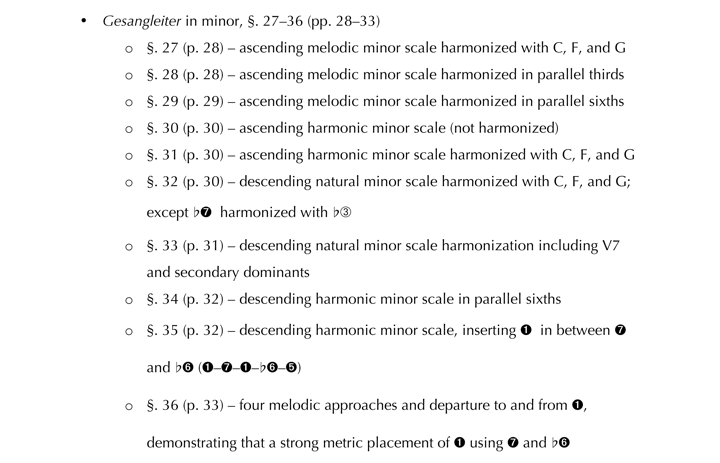The Gesangleiter in Joseph Riepel’s Baßschlüssel (1786) – Second Part and Conclusion
Stefan Eckert
The descending Gesangleiter, taking up §. 14–26 (pp. 17–26), includes a tonicization of the dominant, an extensive discussion of cross-relation, and several schemata (Romanesca (§. 18), Prinner (§. 22), and Quiescenza (§. 24)). Examples 31–33 (§. 14–15a and 15b) harmonize the descending scale degrees ➐–➏–➎ with ➄–➁–➄ or ➄–♯➃–➄, that is with G–D–G and G–D6–G respectively (Figure 8) with the comment “We have seen this hasty departure from the main key into the fifth in the Generbaßleiter above.” Aligning both, Gesangleiter and Baßleiter, Riepel further conflates Baßleiter and Generalbaß into Generbaßleiter, which up to this moment in the Baßschlüssel appeared separately. The term Generbaßleiter highlights the close relationship between Thoroughbass and the octave rule and may indicate how futile it is to keep these two concepts separated because they overlap in so many ways. While Riepel highlights the Grundbaßnoten C, F, and G in his harmonization of the ascending scale, the harmonization of the descending scale adds D, which he describes as a “swift deviation from the main key to the fifth.”[1]
Aligning both, Gesangleiter and Baßleiter, Riepel further conflates Baßleiter and Generalbaß into Generbaßleiter, which up to this moment in the Baßschlüssel appeared separately. The term Generbaßleiter highlights the close relationship between Thoroughbass and the octave rule and may indicate how futile it is to keep these two concepts separated because they overlap in so many ways.[2] While Riepel highlights the Grundbaßnoten C, F, and G in his harmonization of the ascending scale, the harmonization of the descending scale adds D, which he describes as a “swift deviation from the main key to the fifth.”[3]
Example 31: Descending Gesangleiter §. 14, p. 17
Example 32: Descending Gesangleiter §. 15, p. 18
Example 33: Descending Gesangleiter §. 15b, p. 18
Figure 8: Simple Harmonizations of the Descending Gesangleiter, §. 14 and 15a&b
The main difference between §. 14 and 15 (Examples 31 and 32) is that Riepel divides the octave in §. 14 into two sections, section one lasting from ➊–➎ and section two from ➍–➊. The section break undermines the parallel octaves resulting from harmonizing ➎ with ➄ and ➍ with ➃ if the example would move in one section through scale degrees [➏–]➎–➍[–➌]. §. 15 (Example 32) remedies this situation by harmonizing ➍ with ➅, with avoids the parallels and allows an uninterrupted scale harmonization. While Riepel takes recourse to the Baßleiter in harmonizing scale degree ➏ with a D major chord in the context of the scale-wise descent ➐–➏–➎, it is curious that he does not draw on the Baßleiter and harmonize scale degree ➍ with a V7 chord in the descent ➎–➍–➌. However, harmonizing ➎–➍–➌ with ➄–➅–➀ works well, because the ➄–➅ (V–IV6) deceptive motion helps to prepare the final I–V–I of the ➌–➋–➊. Finally, Example 33 (§. 15b) simply replaces the root D with its third F♯, which provides for a smoother bass line.
“However,” Riepel continues, “one could remain in the main key, if one could tolerate peaceful cross-relation.” [4]
Harmonizing ➐–➏ in the soprano with ➄–➃ in the bass, which results in a G major to F major progression in mm. 2–3 of Example 34 (§. 16), Riepel identifies the Mi contra Fa (➐–➃), or cross-relation (Querstand), in the outer voices, that is, the presence of scale degree ➐ in the soprano followed one note later by scale degree ➃ in the bass, with an extended front slash.
Example 34: Descending Gesangleiter §. 16
Stating that the “old [masters] condemned such two major thirds in a descending Gesangleiter,” Riepel explains in a footnote that this concerns “especially [two major thirds] between the highest voice and the bass; yet, only in certain positions and turn of phrases.”[5] Marking the example containing the cross-relation with “§. 16” (Example 34), Riepel seems to indicate that he considers the example part of the Gesangleiter, despite the fact that he explicitly points out in most of the following examples (§. 17–22) how they avoid the Mi contra Fa (➐–➃). Example 35 introduces the Romanesca bass with its characteristic bass motion of a descending fourth followed by an ascending second (➀–➄–➅–➂–➃–➀), provides an effective harmonization of the stepwise descending soprano with root position chords. [6] Though unusual, Examples 36 (§. 18), harmonize the descending scale with a Romanesca starting on A, or scale degree ➅. Riepel argues that the cross-relation (➐–➃) between mm. 2–3 in Example 36 matter less because of the two-measure units created by the sequential bass motion.
Example 35: Descending Gesangleiter §. 17, p. 18
Example 36: Descending Gesangleiter §. 18, p. 19
Similar to §. 5 and 6, which focused on harmonizing the ascending scale using thirds and sixth respectively, Examples 37–39 (§. 19–21), focus on intervallic relationships. Example 37 (§. 19) moves in parallel 3rds, 38 (§. 20) in parallel 6ths, and 39 (§. 21) combines sixths and thirds. Throughout his discussion of intervallic relationships, Riepel highlights how the respective examples address the cross-relation. While the sixth below scale degree ➏ prevents the cross-relation in Examples 38 and 39, Riepel argues that the cross-relation in Example 37 are mitigated by the opening minor third and the two-measure unit. In support of this, he rewrites several of the examples to demonstrate that they can be conceptualized in two-measure groups.
Example 37: Descending Gesangleiter §. 19, p. 19
Example 38: Descending Gesangleiter §. 20, p. 20
Example 39: Descending Gesangleiter §. 21, p. 20
Example 40 (§. 22) avoids the cross-relation by inserting an additional note (measure) between scale degrees ➐ and ➏, resulting in two different soprano lines: ➊–➐–➊–➏ and ➊–➐–➌–➏. It is noteworthy that the harmonization of the second soprano line’s last four notes ➏–➎–➍–➌ in parallel thirds creates a Prinner. [7]Riepel considers this and the following example (Examples 40 and 41) “good diatonic turn of phrases” (gute diatonische Sätze) which have been used by ancient masters. [8] It is noteworthy that only the last six notes consist of a descending scale from ➏ to ➊, the beginning of a sequence of ascending fifth harmonizing a ➌–➋–➍–➌ soprano.
Example 40: Descending Gesangleiter §. 22, p. 20
Example 41: Descending Gesangleiter §. 23, p. 21
Examples 42–43, §. 24–25, show both a stepwise ascending and descending soprano above a tonic-pedal bass. In the case of the stepwise ascending soprano, the last four notes, ➎–➏–➐–➊, create a Quiescenza with 5/3, 6/4, 7/4/2, and 5/3 above the pedal which can appear both with and without chromatic alterations.[9]
Example 42: Ascending Gesangleiter §. 24, p. 21
Example 43: Descending Gesangleiter §. 25, p. 21
Finally, Example 44 (§. 26) appears in the context of examples that demonstrate an application of the descending Gesangleiter. Unlike the other illustrations of the rules for the descending Gesangleiter, Riepel presents Example 44 in an open three-part score (violin, viola, and bass). While Examples 42 and 43 demonstrate ascending and descending scale harmonizations above a tonic pedal, this final example harmonizes a sustained tonic in the soprano.
Example 44: Descending Gesangleiter §. 26, p. 26
Except for the five-page distance between §. 25 (Example 43) and §. 26 (Example 44), which makes §. 26 appear almost like an afterthought, the thirteen rules for harmonizing an ascending Gesangleiter (§. 1–13) are followed by thirteen rules for harmonizing a descending Gesangleiter (§. 14–26). Similar to the treatment of the ascending Gesangleiter, which was first introduced and then exemplified, pp. 21–25 also present examples for how to apply the rules of the descending Gesangleiter. Most of the examples demonstrating the application of the Gesangleiter are in three or more parts, which is helpful for clarifying some of the harmonically ambiguous rules. Except for Example 46, which consists only of four measures, all examples create a complete harmonic and melodic context. That is, all begin on and end with a cadence in the tonic C major.
Example 45 combines both rules §. 14 & 15. That is, D is harmonizing scale degree ➏ as a secondary dominant to G as a detour to the fifth of the key, (Abweichung in die Quinte), and ➎–➍ are harmonized by ➄–➅ (V–IV6), which avoid the parallel octave that would result from successive root position chords of ➄–➃ (V–IV).
Example 45: Application of the Descending Gesangleiter according §. 14 & 15, p. 21
Examples 46 highlight again the Mi contra Fa (➐–➃), or cross-relation (Querstand), in the outer voices. Riepel argues that the second example with its rest on the last beat of m. 2 moderates the cross-relation at (✝). Following this example, Riepel demonstrates other harmonic means to avoid the cross-relation. Most important is the use of a minor seventh, that is scale degree ➆ below scale degree ➏, resulting in half-diminished seventh chord, which resolves to the tonic (➏–➎ harmonized by ➆–➀).
Example 46: Application of the Descending Gesangleiter according §. 16, pp. 21–22
Examples 47 and 48 both make use of the Romanesca schema, which consists of a descending fourth and ascending second sequence harmonized by root position chords. While the Romanesca usually starts on scale degree ➊, moving ➊–➎–➏–➌–➍–➊, Example 48 begins the pattern on scale degree ➏, moving ➏–➌–➍–➊–➋–➏. In contrast to Example 36 which seemed harmonically ambiguous because it started on A and ended on C, Example 48, both begins and ends with a cadence in the tonic harmony C (with the bass motion ➊–[➏–…–➏]–➍–➎–➊), thus ensuring that the Romanesca does not move out of the key of C.
Example 47: Application of the Descending Gesangleiter according §. 17, p. 22
Example 48: Application of the Descending Gesangleiter according §. 18, p. 23
Examples 49 and 50 largely move in parallel thirds and sixths respectively. Both examples also emphasize the grouping in two-measure unit, which according to Riepel diminish the impact of the Mi contra Fa (Example 49, mm. 2–3). In addition, the harmonization of ➏–➎–➍–➌ (Example 49, mm. 3–6) contains a Prinner.
Example 49: Application of the Descending Gesangleiter according §. 19, p. 23
Example 50: Application of the Descending Gesangleiter according §. 20, p. 23
Example 51, most importantly, inserts scale degree ➊ in between ➐–➏, resulting in ➊–➐–➊–➏. In addition, the ➏–➎–➍–➌ in mm. 4–7 contains a Prinner.
Example 51: Application of the Descending Gesangleiter according §. 22, p. 24
Examples 52 and 53 finally, provide four-part harmonizations of the “good diatonic turn of phrase” (ascending fifth sequences leading into a harmonization of ➏–➎–➍–➌), and of the tonic pedal below an ascending and descending scale. The examples also contain a Prinner and Quiescenza respectively.
Example 52: Application of the Descending Gesangleiter according §. 23, p. 25
Example 53: Application of the Descending Gesangleiter according §. 24 & 25, p. 25
Following the ascending and descending Gesangleiter in major, Riepel also provides brief examples for the Gesangleiter in minor §. 27–36, which reiterates many of the rules for the Gesangleiter in major. Figures 9 and 10 summarize rules §. 27–28 and 29 respectively, which provide guidelines for harmonizing ascending melodic minor scales. Similar to Example 5 (§. 3), the bass for §. 27 uses exclusively the Grundbaßnoten C, F, and G; similar to Examples 8 and 9 (§. 5 and 6) the bass for §. 28 and 29 move in parallel thirds and sixth respectively. In Figure 10 (§. 29), Riepel separates the last four notes from the first five in order to diminish the effect of the Fa contra Mi, that is scale degree ➍ in the soprano followed by scale degree ➆ in the bass.
Figure 9: Harmonizations of the Ascending Melodic Minor Scale, §. 27
Figure 10: Harmonizations of the Ascending Melodic Minor Scale, §. 29
Writing out an ascending harmonic minor scale as §. 30, Riepel comments on the augmented second ♭➏–➐, stating,“this scale is quite natural until the A♭ (that is, including Fa). If only the B as an improper Mi were not to follow. Placing a note in between, it is however quite possible to make the scale natural.”[10] Figure 11 (§. 31) demonstrates the mitigation of the augmented second with either ➎ or ➊ in between ♭➏ and ➐. While the first version (Bass 1) harmonizes the ascending scale using only C, F, and G, the second (Bass 2) uses first inversion chords as indicated.
Figure 11: Harmonizations of Ascending Harmonic Minor Scale, §. 31
Concerning the descending minor scale, Riepel provides rules for the descending natural minor (§. 32 and 33, Figure 12) followed by four additional example basses (Figure 13) and rules for the harmonic minor scale (§. 34–36, Figure 14). In §. 32, Riepel expands the Grundbaßnoten C, F, G to include E-flat, that is, the major triad above ♭➂; in §. 33, he also includes a first inversion chord above ➃ and harmonizes ➍ in the soprano with either ➃ or ➄ (V7). The four basses in Figure 14 demonstrate a range of chromaticism, including tonicizations of the subdominant below ♭➐ and bº6 chords below scale degree ➍ in basses 3 and 4. Noteworthy is the harmonic ambiguity of scale degree ➎: the “3” in basses 1 and 2 potentially allows both a root position E-flat major or a first inversion c minor chord (Riepel usually uses “5” to indicate root position chords, yet in rare cases also “3”).
Figure 12: Harmonizations of the Descending Natural Minor Scale, §. 32 and 33
Figure 13: Additional Harmonizations of the Descending Natural Minor Scale
The descending harmonic minor scale does contain, of course, the augmented second, which Riepel addressed as Fa–Mi (♭➏–➐) in § 30 and 31. In order to avoid problems resulting from harmonizing the descending ➐–♭➏, Riepel suggests two solutions: §. 34 does not harmonize ➊–➐, but harmonizes the rest of the scale in parallel sixth starting on ♭➏, §. 35 adds a ➊ resulting in a ➐–➊–♭➏ line. [11] In addition, Riepel provides a final melodic example (§. 36, p. 33) in which he demonstrates how the ascending ➎–♭➏–➐–➊ and descending ➊–➐–♭➏–➎ harmonic minor scale with its augmented second can be made easier to sing if scale degree ➊ is placed on metrically accented beats.
Figure 14: Harmonizations of the Descending Harmonic Minor Scale, §. 34 and 35
Finally §. 37–45 (pp. 53–71) provide a somewhat loose collection of examples addressing issues related to both the Baßleiter and Gesangleiter; I have summarized the topics in Figure 14 below. The content and organization of these examples is similar to the material covered in the twenty pages that precede them (pp. 33–53), where it is difficult to find any overarching organization and specific focus that would help unify these pages. As a result, the content and structure of these pages stand in stark contrast to the focused presentation with which the Baßschlüssel opened. On the other hand, the content and structure of the pages following the discussion of the Gesangleiter in minor (pp. 33–83) is not unlike the roaming dialogues in large sections of Riepel’s Anfangsgründe. The pages outlined in Figure 15 address basic issues of dissonant treatment (§. 37), the importance of parallel first inversion chords for harmonizing stepwise ascending and descending lines (§. 38–39), the treatment of chordal sevenths in root position and inversions (§. 40–41), the nature of 6/4 chords (§. 42), acoustic principles related to the Grundbaßnoten (§. 43), the chromatic scale (§. 44), and the harmonization of scale degrees ➀–➂–♯➁–♮➁–➀ and ➀–♯➃–➄ with chromatic, especially diminished seventh chords (§. 45). All of these issues are more or less relevant to the overall goal of the Baßschlüssel and often demonstrated with more than one example.
Figure 15: Chromatic and Other Alterations for Gesang- und Baßleiter, §. 37–41, 42, 43, 44, and 45 (pp. 53–54, 56, 61, 62, and 71)
Similar to the Baßleiter, the Gesangleiter (Figure 16) is based on some shared principles without actually creating a strict method. While the Gesangleiter starts out with a claim for a unified theory, §. 1–2 argue that everything derives from the Grundbaßnoten C, F, and G and §. 3–4, §. 14–15, 31–32, and 27 use mostly the I, IV, and V chords first in root position then in first inversion–the remainder of the Gesangleiter cannot be described as a logical outcome of this opening. §. 5–8, §. 19–21, 28–29, and 34 incorporate intervals (first 3rds and 6ths, then 5ths and 8ves), §. 9–11 and 33 introduce chordal sevenths and §. 12–13 chromaticism and §. 17–18, 22–26, and 35–36 focus on various local solutions and schemata (Romanesca, Prinner and Quiesenza) to address problematic harmonic issues such as the cross-relation and augmented seconds. Riepel’s approach to the Gesangleiter is thus not unlike his approach to harmony in general, that is rather than theorizing harmony as a system, Riepel appropriates aspects of harmony and counterpoint and applies them to specific moments without a concern for an overarching method or system.
Figure 16: Summary of the Gesangleiter
In summary, I believe that Riepel’s Gesangleiter succeeds in outlining a method for writing a bass against a melody that goes extensively beyond the simplistic method suggested in the opening where all harmonic content is reduced to C, F, and G, that is, the tonic, subdominant, and dominant harmonies. While this opening suggests an approach linked to or based on Daube’s General=Bass in drey Accorden (Figured Bass in Three Chords) published in 1756, Riepel neither generates all bass notes strictly harmonically, nor does he agree with Daube’s 6/5 chord above scale degree ➃.[12] Instead, Riepel’s thirty-six rules for the Gesangleiter also borrows principles from the Baßleiter and in many instances combines harmonic and contrapuntal procedures for the purpose of writing a bass that both supports the melody and results in an independently recognizable musical line. The fact that there exist no traces of the Gesangleiter in the wake of the Baßschlüssel may be due to a combination of issues, most significantly, because counterpoint–in its close affiliation with partimento and solfeggio practice–already provides the tools for writing such bass lines, and it would seem that only amateurs without much formal training might be interested in Riepel’s approach. However, the Baßschlüssel documents Riepel’s wrestling with issues of melody, harmony, and counterpoint and provides us with an eighteenth-century insight into issues that are still relevant for the training of musicians today.
Discussion of the Manuscript Pages from Joseph Riepel’s Baßschlüssel
Unlike the printed version of the Baßschlüssel, the manuscript pages are in dialogue form and contain references to the typical cast of characters that teacher and student invoke in order to discuss scientific, rational, and Pythagorean approaches to music; however, the former Schulmeister from Monsberg seems to have become a Capellmeister, while the Vetter Hansmichel is now addressed as Herr Hansmichel.[13] The following brief discussion identifies some of the most important features of the manuscript pages in relation to the printed version of the Baßschlüssel.
The introduction, pp. 41–42, relates to page 61 in the Baßschlüssel, where Riepel addresses his apparent acoustic findings on the violin. The corresponding section in the printed version of the Baßschlüssel presents different examples (Example 1), yet the overall discussion is very similar. The following presents a short excerpt:
Example 1: §. 43, p. 61
If one plays No. 1, the thirds and sixth, emphatically and in tune on the violin, and, while playing, holds the left ear close to the strings, it is possible to perceive the lower pitches notated in the viola rasping. […] If at No. 2, a violinist has a somewhat heavy tabacco tin placed just behind the bridge, everyone can hear the buzzing of the notated very low bass (in consideration of the small instrument).[14]
In the printed version of the Baßschlüssel, this claim about perceived chordal roots below thirds and sixths appears as a curious side note concerning the nature of Grundbaßnoten (fundamental-bass notes). It is followed, on the same page, by a discussion of a Beginning-Ritornello (Anfangs-Ritornell), without further clarification or discussion and despite the fact that page 61 is prominently mentioned in the introductory “Letter of the Author to his Friend.”[15] While the prominent position of this section in the manuscript opening pages seems to slant the text more strongly towards these apparent acoustic principles, the section ends with a dismissal of the monochord. However, the assertion that there exists only a major mode can be found throughout the manuscript pages and within the printed Baßschlüssel.[16] In addition, both the manuscript pages and the printed version acknowledge that this position fails to derive the minor mode. While this slant towards the major mode helps to explain why both the Baß- and the Gesangleiter pays significantly less attention to the minor mode, it is interesting that both texts repeatedly invoke, dismiss and acknowledge the limits of the monochord. The resulting uncertainty about the status of acoustic principles for compositional practice is not unusual for Riepel’s Anfangsgründe. Indeed, I believe that such moments serve to inform readers about the existence of multiple perspectives and eventually challenge readers to make up their own minds.
The first introduction to the Gesangleiter (pp. 43–49) begins with a reference to the Capellmeister from Monsberg, who either plays or knows of the Maultrommel (Jew’s Harp), which supposedly is able to produce all intervals. In this version, the Discantista reports that Hansmichel and the two musicians from Vallenthal and Urbstadt utilize only three pitches, C, F, and G in order to explain the Baßleiter. The Præceptor continues this thread and derives the bass scale similar to §. 1 and 2 of the Gesangleiter. Instead of Mittelnoten, both designate D, E, A, and B as “abstammende” (derived) pitches that complete the scale together with the Grundnoten C, F, and G. In contrast to the discussion of the Gesangleiter in the Baßschlüssel, the student, the Discantista, proposes a different system for deriving all pitches. He suggests that the C, the third below E-G in the C-E-G chord, is replaced by B, the third above, thus relating C-E-G and E-G-B, similarly F-A-C and A-C-E and G-B-D and B-D-F#. “This invention”, says the Præceptor, “is as casual as useless,” yet he acknowledges that one needs to try to explain all the many sounds in music.[17] Again such a statement is reminiscent of the teacher in the Anfangsgründe, who both draws on and critiques systems. The remainder of the discussion does not directly concern the Gesangleiter, but the student reports of a composer in Opolisburg, who claims that he can teach his system of composition within a week’s time using simple bass motions harmonized in parallel thirds and sixths, which the teacher judges as old and formal.
The second introduction to the Gesangleiter (pp. 49–52) begins with a reference to the Baßleiter. Unlike the Baßschlüssel and the first introduction, this discussion does not derive the scale from the triads above C, F, and G. Instead, the Præceptor simply states, “in this key, the note C is the Grundnote [fundamental note] because the melody begins and ends with it. It [C] is hereby interrupted by G, because it is necessary for creating a complete cadence. The note F takes care of the Amen cadence as can be seen in the five different cadences in Chapter Five page 56.”[18] Thus instead deriving the scale from harmonic principles, the argument here is focused on observations and examples taken from practice, an approach that is not uncommon in the Anfangsgründe. Declaring unison, octave, fifth, third, and sixth consonances, the Præceptor, then “every essential note in the melody must be accompanied by at least one of these five consonances.”[19] Thus, even though the basic harmonization of the scale is based on C, F, and G, the student-teacher discussion solely focuses on consonances and dissonances, and highlights counterpoint, as the cause for harmonizing the scale.
While I have described the twelve manuscript pages as structured in roughly three sections, because of visual breaks and apparent beginnings in the text, it is also possible to consider all pages a continuous introduction to the Gesangleiter. Such a view would be supported by the fact that there exist several references to earlier moments in the text. For example, the discussion of the Maultrommel (see page 43), seems to respond to the limits of the monochord, the emphasis on C, G, and F (pages 44 and 50) could be considered related. However, due to the limited material, the status and function of these pages remains unclear and any conclusions seem preliminary. Having spent a significant amount of time with this material, I do recognize that they should be best addressed in the larger context of the Anfangsgründe, because Riepel’s teachings on harmonic and contrapuntal issues, while fragmented, seem to be part of a larger thread that appears throughout his writings.
Notes
“Diese eilfertige Abweichung von der Haupttonart in die Quinte haben wir auch oben bey der Generalbaßleiter gesehen” (Riepel Baßschlüssel, 17). | |
Giorgo Sanguinetti begins his 2007 article by discussing the close relationship between thoroughbass and partimento, of which the octave rule is an important aspect. Sanguinetti’s most pronounced difference between thoroughbass and partimento, speaks to the independence of the partimenti, because thoroughbass is usually meant to accompany something, thus is in service to some other musical force. | |
“[…] eilfertige Abweichung von der Haupttonart in die Quinte.” I am taking the liberty to translate “eilfertig” as “swift” despite that it literally translates into “rash,” because I detect no negative connotations in the German text. | |
“Man könnte dagegen durchaus in der Haupttonart bleiben, wenn ein fridlicher Querstand zu dulden wäre” (Riepel Baßschlüssel, 17). | |
“… von den alten zwo große Terzen nur in absteigender Gesangleiter für verwerflich gehalten worden sind.* [*) Und zwar fordersamst zwischen der obersten Stimme und dem Basse; aber nur in gewissen Lagen und Wendungen” (Riepel Baßschlüssel, 18). | |
I want to thank Robert Gjerdingen for pointing out the Romanesca in the first place. See Gjerdingen 2007 Chapter 2, pp. 25–43 for a discussion of the Romanesca schema. | |
See Gjerdingen 2007 Chapter 3, pp. 45–60 for a discussion of the Prinner, which provides a common harmonization of a stepwise descend ➏––➍–➌. | |
See Riepel, Baßschlüssel, 20–21. | |
See Gjerdingen 2007 Chapter 13, pp. 181–195 for a discussion of the Quiescenza. For a diatonic Quiesenza see Ex. 13.1, for a chromatic variant Ex. 13.2 (pp. 181–182). | |
“Bis zum ab (also fa) inclusive ist diese Leiter ganz natürlich; wenn mir das h als ein hierzu ungehöriges mi nicht darauf folgte. Es läßt sich aber die Leiter mit einer dazwischen gesetzten Note durchaus natürlich machen, z. Ex.” (Riepel Baßschlüssel, 30). | |
I assume that the example §. 35 contains a printing mistake, because the bass in m. 3 reads E-flat with a raised 6 above and a C in the soprano. The progression, however, seems to make most sense with an E in the bass as a leading tone to F. | |
Diergarten 2008 provides an insightful summary of Daube’s compositional approach. | |
See Eckert 2000, pp. 30–35 for a general discussion of the dialogue in Riepel’s Anfangsgründe and especially pp. 34–35 for a specific discussion of the cast of characters. | |
“Streicht man auf der Violine No. 1 die Terzen und Sexten außerordentlich stark und sehr rein zusammen, und hält währendem Streichen das linke Ohr nache au den Saiten, so vernimmt man die unten in der Bratsche geschriebenen Noten deutlich mit raspeln. […] Bey No. 2 läßt sich ein Violinist währendem Streichen linker Hand hinten knap an dem Steg (oder Sattel) eine mher schwer als leichte Tabacksdose hinlegen, so hört jederman umher den unten geschriebenen (in Ansehung des so kleinen Instruments) sehr tiefen Baß mitbrummen” (Riepel, Baßschlüssel, 61). | |
Riepel, Baßschlüssel, Schreiben des Verfassers an seinen Freund. | |
See Riepel, Baßschlüssel, pp. 6–7. | |
“Diese Einbildung ist so lässig als Vergeblich” (Riepel, Baßschlüssel Ms, 46.) | |
“Præc. In dieser Tonart ist die Note C folglich eine Grundnote, weil der Gesang insgemein damit angefangen und geendigt wird. Hierauf unterbricht sie die Note G, weil sie zu einer vollkommenen Cadenz notwendig ist. Die Note F besorgt die Amen-Cadenz so wie im 5ten Cap: S: 56 die fünferley Cadenzen zu sehen sind” (Riepel, Baßschlüssel Ms, 50). | |
“[…] muß jede wesentliche Note des Gesangs zum wenigstens von einer aus diesen fünf Consonanzen begleitet warden, […]”(Riepel, Baßschlüssel Ms, 51). |
Sources
Christensen, Thomas. 1992. “The Règle de l’Octave in Thorough-Bass Theory and Practice.” Acta Musicologica LXIV(2): 91–117.
Daube, Johann Friedrich. 1756. General=Bass in drey Accorden, gegründet in den Regeln der alt= und neuen Autoren, nebst einem hierauf gebaueten Unterricht: wie man aus einer jeden aufgegebenen Tonart, nur mit zwey Mittels=Accorden, in eine von den drey und zwanzig Tonarten die man begehret, gelangen kann, und der hierauf gegründeten Kunst zu präludieren, wie auch zu jeder Melodie einen Baß zu stetzen, daß also durch diese neue und leichte Anleitung, zugleich auch zur Composition unmittlebar der Weg gebahnet wird. Frankfurt am Mayn: Andrä / Leipzig: Breitkopf.
Diergarten, Felix. 2008. “Anleitung zur Erfindung. Der Musiktheoretiker Johann Friedrich Daube,” Musiktheorie 23/4, 299–318.
Eckert, Stefan. 2000. ‘Ars Combinatoria,’ Dialogue Structure, and Musical Practice in Joseph Riepel’s ‘Anfangsgründe zur musicalischen Setzkunst.’ Ph.D. State University of New York at Stony Brook.
–––. 2007. “Einschnitt, Absatz, and Cadenz – The Description of Galant Syntax in Joseph Riepel’s Anfangsgründe zur musicalischen Setzkunst,” THEORIA – Historical Aspects of Music Theory, vol. 14, 93–124.
Emmerig, Thomas. 1984. Joseph Riepel (1709–1782): Hofkapellmeister des Fürsten von Thurn und Taxis. Biographie, Thematisches Werkverzeichnis, Schriftenverzeichnis (= Thurn und Taxis-Studien 14), Kallmünz: Michael Lassleben.
–––. 1996. Joseph Riepel. Sämtliche Schriften zur Musiktheorie (= Wiener Musikwissenschaftliche Beiträge 20), Wien, Köln, Weimar: Böhlau.
Gjerdingen, Robert O. 2007. Music in the Galant Style: Being an Essay on Various Schemata Characteristic of Eighteenth-Century Music for Courtly Chambers, Chapels, and Theaters, Including Tasteful Passages of Music Drawn from Most Excellent Chapel Masters in the Employ of Noble and Noteworthy Personages, Said Music All Collected for the Reader’s Delectation on the World Wide Web, New York: Oxford University Press.
Jans, Markus. 2007. “Towards a History of the Origin and Development of the Rule of the Octave.” In Towards Tonality: Aspects of Baroque Music Theory (Leuven: Leuven University Press), 119–143.
Lester, Joel. 1992. Compositional Theory in the Eighteenth Century. Cambridge, MA and London: Harvard University Press.
Marpurg, Friedrich Wilhelm. 1755. “VI. Vermischte Neuigkeiten,” Historisch-kritische Beyträge zur Aufnahme der Musik (I): 342–343.
Sanguinetti, Giorgio. 2007. “The Realization of Partimenti: An Introduction,” Journal of Music Theory 51(1): 51–83.
Riepel, Joseph. 1755. Grundregeln zur Tonordnung insgemein. Abermal durchgehends mit musicalischen Exempeln abgefaßt und Gesprächs-weise vorgetragen, Regensburg: Krippner.
–––. 1786. Baßschlüssel, das ist, Anleitung für Anfänger und Liebhaber der Setzkunst, die schöne Gedanken haben und zu Papier bringen, aber nur klagen, daß die keinen Baß dazu zu setzen wissen, Regensburg: Johann Kaspar Schubarth.
–––. 1996. Sechstes Capitel vom Contrapunct. Edited by Thomas Emmerig. Joseph Riepel, Sämtliche Schriften zur Musiktheorie. Vol. I. Wien: Böhlau, 527–634.
Wiener, Oliver. 2003. ‘Ein ganzes Duzend Manuductionen’ - Joseph Riepels Desintegration der Gradus ad Parnassum von Johann Joseph Fux. Jahresgabe 26 der Johann-Joseph-Fux-Gesellschaft. Graz.
Wolf, Eugene K. 1981. The Symphonies of Johann Stamitz: A Study in the Formation of the Classical Style, Hague and Boston: Maninus Nijhoff.
Dieser Text erscheint im Open Access und ist lizenziert unter einer Creative Commons Namensnennung 4.0 International Lizenz.
This is an open access article licensed under a Creative Commons Attribution 4.0 International License.














